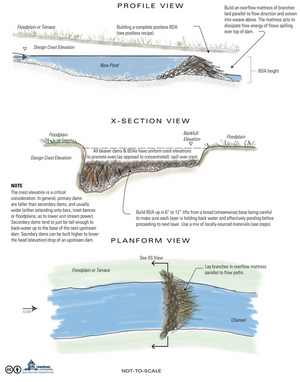Beaver Dam Analogues (BDAs) Recipes
There are a large number of ways to construct beaver dam analogues. We are partial to those that take their inspiration most directly from beaver. In many places where beaver build dams, they do so successfully without posts driven vertically into the streambed. Our most common recipe for BDAs is the postless BDA shown above (Figure 4.32).
If you feel posts are necessary for temporary stability, we recommend first building a postless BDA and then installing posts afterward (see Figure 4.34).
-
Postless-BDA Recipe
Figure and construction details -
Post-Assisted BDA Recipes
Figure and construction details
Some of the original and experimental BDA designs are described in Appendix C of Chapter 4. We do not usually recommend these early designs, as variations of the above tend to build more quickly and work better. However, they have still successfully promoted beaver dam activity in many cases and are included for your consideration.
We encourage practitioners to experiment with different recipes while adhering to the LTPBR Restoration Principles. For more details, see Chapter 4, or Module 5E on BDA construction.
Confusion about BDAs
In Module 2F, we talk about the many confusing uses of the term BDA and related terminology. Just because something is called a BDA does not mean it meets the LTPBR definition in Wheaton et al. (2019).
A BDA, per the LTPBR Standards of Practice, is a temporary structure meant to promote the process of beaver dam activity. BDAs can sometimes temporarily mimic beaver dams to, for example, provide safe ponds for translocated beaver or support riparian vegetation establishment. Like natural beaver dams, BDAs require maintenance (ideally by beaver) to persist, and they come and go, leaving a dynamic mosaic of habitat.
Module 2F Resources
Video
Watch on YouTube
Point in Module 2F lecture discussing BDA terminology.
The Science Behind LTPBR - Slides (PDF)
Recipes
Appendix E – Typical Schematics and General Suggestions
All figures and recipes in Appendix E of Chapter 4 are available for download and citation:
DOI: 10.6084/m9.figshare.14445567.v1

